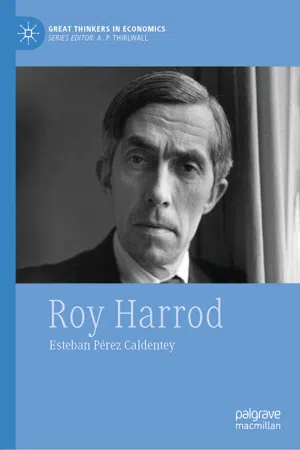1.1 Family Background and Early Beginnings
(Henry) Roy Harrod Forbes was born on 13 February 1900, in Norwich, Norfolk.1 He was the only child of Henry Dawes Harrod (1858–1918) and Frances Marie Desiree Forbes-Robertson (1866–1956). Henry Dawes studied at New College in Oxford but left to become a solicitor. He also became a member of the London metals exchange.
Dawes Harrod’s interests expanded beyond those of the business world. He followed his father’s footsteps as an antiquarian of the late nineteenth century and was a Fellow of the Society of Antiquities and of the Royal Society. He also wrote two historical monographs published in 1891 (The Muniments of Shavington and the History of Shavington in the County of Salop) (Eltis 2008, p. 595; Phelps Brown 1980, p. 1).
The first publication is a catalog of indentures and deeds housed in Shavington Hall in Shropshire.2 For its part, the History of Shavington “illustrates the complete formation of an English state” (Harrod 1891, p. 2) from 1066 to 1885. It focuses on the hereditary disputes related to the Shavington Estates and a family chapel at Adderley Church that took place in the seventeenth century between the families of Needhams of Shavington and the Corbets of Adderley.3 In addition, Dawes Harrod authored two articles (A Defence of the Liberties of Chester, 1450, and the Chester Rows, 1900b) dealing with the imposition of taxes by the English Parliament in Cheshire in 1450.4
Initially, Dawes Harrod benefited greatly from his activities in the metals exchange, but his fortune changed for the worse, and he mortgaged his capital on a bad investment in a copper mine in Anglesey (Wales) at the beginning of the 1900s and then subsequently suffered stock market losses in 1907.5 He was faced with bankruptcy for ten years and had to be content with a much-reduced income on which to bring up his family. The whole affair had a devastating effect on him and he was not able to bounce back. According to Phelps Brown (ibid., p. 3): “…it always remained a mystery to him (Roy Harrod) that a man of such great ability (Dawes Harrod) had been able to do nothing to retrieve his fortune.” Dawes Harrod died in 1918 leaving the family penniless. Roy Harrod would later describe growing up in intense poverty as the keynote memory of his childhood.6
Harrod’s mother, Frances, came from an artistic background. His maternal grandmother was the art critic for the London Sunday Times. Her brother (Sir Johnston Forbes-Robertson) was a well-known Shakespearean actor-manager. Frances is said to have been a well-known Victorian novelist (Hinshaw 1978, p. 364), a painter, and accomplished in musical composition (Phelps Brown, ibid., p. 1; Berlin, p. 710).7 She also befriended some of the most celebrated literary figures of the time including Henry James, Oscar Wilde, and George Meredith. Harrod’s mother invited Oscar Wilde to her wedding in April 1899 and he sent her as a wedding present one of the twelve Japanese vellum copies of The Importance of Being Earnest “in the hopes it may live on your bookshelves and be allowed to look at you from time to time” (Wilde 1962, p. 802).8 Her close friendship with Wilde is also revealed by the fact that earlier on in 1897 he had sent her parts of De Profundis that showed his mental state while he was in prison.9
Frances played a significant role in Harrod’s life inculcating in him the love of literature and art. Harrod recalls being “brought up in a literary and artistic home in which the tradition was that conversation was by far the greatest pleasure, if not the prime object, of life” (1959a, pp. 39–40). At the same time, she suffered from chronic depression, just as Roy Harrod would later on in his life, probably due, in part, to her financial situation. She imposed upon him her “exhausting emotional demands and melancholy” (Berlin 2012, p. 710). Harrod remained attached to his mother but experienced conflicting feelings toward her. He was grateful for her guidance during his childhood years and felt responsible for her. At the same time, he viewed her as an obstacle to his development as an economist and as an emotional drain. Harrod went so far in his antagonistic feelings toward her that he considered putting an end to her life.10
In spite of the family’s financial situation, Harrod managed to progress with his education by winning several scholarships including St. Paul’s School in 1911, a King’s Scholarship to Westminster School in 1913 where he became Head of his House in 1917, and a history scholarship to New College, Oxford, in 1918 (see Oxford Dictionary of National Biography 2004).
At Westminster School, Harrod studied under Isaac Frank Smedley (1870–1934) and John Sargeaunt (1857–1922) majoring in classics before switching to history in his last two years. Harrod felt great affection for Sargeaunt who had a permanent influence on his life. Harrod referred to Sargeaunt as one of the most cultivated minds he knew (1974, p. 113).11 Harrod is described as: “outgoing, talkative and argumentative, wide-ranging in his interests and reading, generous, and humane in his impulses, sensitive and earnest; but no good at games” and also tolerant and hateful of intolerance as well as compassionate (Phelps Brown, p. 4).
